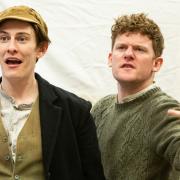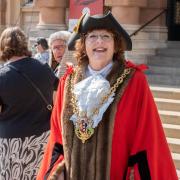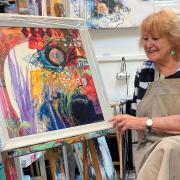It was probably a woman who organised the ship burial of an Anglo-Saxon king at Sutton Hoo. It was certainly a woman who decided to excavate the site. Now a woman is leading the project to reconstruct the mighty ship which changed our knowledge of British history.
The unearthing of the mysterious mounds at Sutton Hoo in 1939 was one of the most important excavations in British history. Extraordinary riches discovered within the shadow of a vast wooden ship opened a window into our ancient past. The story behind the discovery, led by local man Basil Brown at a time when Britain was threatened by war, was no less intriguing as the recent success of the film The Dig proved.
But this fictionalised account merely touched on some of the determined and pioneering individuals involved in this key Anglo-Saxon find, many of them women. Landowner Edith Pretty, archaeologist Peggy Piggott and photographers Mercie Lack and Barbara Wagstaff each made a tremendous contribution, particularly notable in what was a male dominated field.
With work underway to reconstruct the vast ship which was buried under Suffolk soil, there are once again some formidable and inspiring women sharing their insight and expertise in unlocking the secrets of Britain’s ancient maritime history.
Jacq Barnard, project manager
There are some 60 people currently engaged at the Longshed on the riverfront in Woodbridge, and more will be needed as work progresses. In addition to building the ship, volunteers are fulfilling other tasks such as research, documenting, photography, marketing, fundraising, and rowing trials too, all coordinated and directed by Jacq Barnard.
%image(15714550, type="article-full", alt="Jacq Barnard hopes the newly formed Woodbridge Coastal Rowing Club will feed into her Saxon rowing squad which will need around 120 rowers to undertake the water-based trials when the Sutton Hoo Ship is seaworthy.")
Having worked as an accountant, auditor, project manager and trainer, Jacq is the former captain of Deben Rowing Club and founder of the newly formed Woodbridge Coastal Rowing Club, making her ideally qualified for this role. “Rowing has opened up all sorts of opportunities for me, and has become something of an obsession,” she says. Indeed, she has competed extensively, winning cups in double sculls and undertaking various endurance rows across the country. But she delights in being able to spend time on the Deben in Woodbridge, which flows not far from the bottom of her garden.
“It’s a fantastic river,” she says, “no two days are the same. And there’s a big network along the river of people using it in different ways, so it’s nice to be part of that. I get a real joy from helping people to experience new things.” Recently she’s found that coastal rowing boats open up river outings to the wider community. She hopes the newly formed Woodbridge Coastal Rowing Club will feed into her Saxon rowing squad. This will need around 120 rowers to undertake the extensive water-based trials when the Sutton Hoo Ship is seaworthy.
%image(15714551, type="article-full", alt="Jo Wood rowing the Sae Wylfling Anglo-Saxon boat on the River Deben.")
“As soon as we launch the ship we will have lots of scenarios to test,” she says. “We don’t know what the original ship was used for before burial. We don’t know how far it would have travelled. Would they have rowed it into battles? Would they have carried cargo? Would they have lived on it? The trials will help us to complete the historical picture.” The trial will take several years but Jacq hopes that there will be many volunteers keen to join her and the Ship’s Company in this exciting journey of discovery.
Jo Wood, volunteer shipbuilder
She may not have picked up a chisel until she was in her late 40s, but Jo Wood is now a key member of the team building a reconstruction of the 90ft Anglo-Saxon boat in what is a unique venture of experimental archaeology.
“It’s a fabulous project to be involved in,” Jo says. “I was so lucky to find it. I’ve got so much from learning these new skills. It’s very different to what I’d learned at college – this is green oak and axe work.” A trained accountant, Jo had been working for charitable organisations overseas for many years, but in 2016 decided she wanted a change. She took time out to pursue a boatbuilding course in Lowestoft.
%image(15714552, type="article-full", alt="Jo Wood standing next to the bow underloute in the Longshed.")
“I had discovered sailing in my early 30s and was looking at how I could build my knowledge around it. I wanted to be creative and do something practical, something completely different from my day job.” She achieved a City and Guilds boatbuilding qualification and looked for the next step. “I realised I’d only scratched the surface,” she says, “but how could I continue in boatbuilding?” Living in Ipswich, she heard of the Ship’s Company’s plans in Woodbridge and volunteered, contributing regular shifts at the Longshed in between her work commitments.
Currently Jo is the only female shipbuilder and although it looks physically challenging work, cleaving the frame of the vast 7th century ship from huge oak timbers, she is contributing as an equal with the other crew members. “It’s about working cleverly,” she says. “We're using the materials and techniques of the Anglo-Saxons, but it’s about using the tools rather than engaging brute force. And it’s important to rotate the tasks, almost like circuit training. You can’t do axe work all day so I will be making scaffolding and handrails with power tools at other times.”
%image(15714553, type="article-full", alt="Jo Wood, working on the reconstruction of the Sutton Hoo ship. "Women are more than capable of being involved in boatbuilding,” she says.")
Jo hopes that other women will be encouraged to get on board with the project. “Women are more than capable of being involved in boatbuilding,” she says. “There are lots of transferrable skills from what are seen as more traditional women’s pursuits – I do a lot of sewing, and woodworking is comparable. You’re using the same precision skills.”
And she says she has gained so much from being involved in the project. “In terms of building my skills and making connections with the local community, and also learning about this amazing history on our doorstep, this has been fabulous. It’s a great journey that I feel I’m on, along with the ship.”
Angela Care Evans, archaeologist
“I’ve sat on many committees discussing how to make a reconstruction of the ship buried at Sutton Hoo,” says Angela Care Evans. “This time it looks like it will actually happen!” Ever since joining the British Museum excavation as a postgraduate in 1967, then becoming curator in the department of Britain, Europe and Prehistory, Angela’s life and career has been linked with Sutton Hoo.
%image(15714554, type="article-full", alt="Archaeologist Angela Care Evans' life and career has been linked with Sutton Hoo since joining the British Museum excavation as a postgraduate in 1967, then becoming curator in the department of Britain, Europe and Prehistory.")
“My first job when I joined the British Museum was to write up the ship,” Angela says. “I was thrown in at the deep end.” She had no Anglo-Saxon knowledge but had been encouraged to take the job by a member of staff who said she would ‘learn on the job’. “I was at the right place at the right time, and never left.
“I remember the first day I was there and walking towards the ship looking down the length from the stern to the prow and being absolutely blown away. It was just extraordinary. It’s an amazing ship, beautifully built, but very damaged and bright yellow from the sand, and it was so big.”
Even in her early days at the museum there was talk of creating a full-size replica ship, she says. “We made a plastercast and then a fibreglass model. We even got a quote from a shipbuilder in Aberdeen. But we didn’t know what we would do with it when it was built, so nothing came of it.”
Later, in the summers from 1984-1992 Angela left London for a flat on the quay at Woodbridge to join the excavations at Sutton Hoo as the British Museum finds specialist. She was working then with Martin Carver who is now the chair of the Ship’s Company, overseeing the reconstruction of the ship on the riverside in Woodbridge. Last year he invited Angela to join him as a trustee of the project and as a member of the ‘Witan’, a resource group of 20 or 30 people with specialist skills, which takes its name from an Anglo-Saxon king’s counsel. Angela hopes to be able to assist in interpreting the archaeological evidence and turning it into a reality.
%image(15714555, type="article-full", alt="Angela Care Evans, assisted by Alec Newland, hammers in the first trenail of the first fix to connect the keel to the stern underloute")
“When I was writing about the ship, it was about the repairs,” she says. “These showed that it wasn’t merely a burial ship. It has taken me a long time to realise that in building the ship, we’re not going to build in the repairs. We’re not building what was found in the grave so much as what was first built. We’re building something real.”
The women of Sutton Hoo
King Raedwald's queen
Sutton Hoo is believed to be the burial site of Anglo-Saxon King Raedwald and one theory is that it was Raedwald’s wife and queen who may have arranged the event, using it to demonstrate her and her family’s power and social standing. The extravagant burial – designed to be visible to all the surrounding countryside - highlighted her husband’s importance and therefore her own, especially important when the kingdom was vulnerable after the king’s death, with others vying for power.
Edith Pretty
Edith Pretty bought Tranmer House at Sutton Hoo and the surrounding estate in 1926, her first home as a married woman with her husband, Frank. Frank died in 1934. Edith had travelled extensively and had seen excavations of the Nile Valley. Her father, Robert Dempster, was a keen amateur archaeologist and had revealed a Cistercian abbey in the grounds of their family home at Vale Royal. Intrigued by the strange mounds on her land, Edith may have drawn on her early experiences with archaeology and recognised the need to have the mounds expertly excavated, which she organised in 1938.
%image(15714556, type="article-full", alt="Edith Pretty, the owner of Sutton Hoo estate, standing on the veranda of Tranmer House")
Archaeologist Peggy Piggott (also known as Margaret Guido)
Peggy Piggott was the first to find gold at Sutton Hoo, after she was called back from her holiday, along with her husband Stuart, to excavate the burial chamber at Sutton Hoo following local archaeologist Basil Brown's discovery. Peggy was an archaeologist, prehistorian, and finds specialist. She had a 60-year career in British archaeology and she is recognised for her field methods, her field-leading research into prehistoric settlements (hillforts and roundhouses), burial traditions, and artefact studies (particularly Iron Age to Anglo-Saxon glass beads). She contributed more than 50 articles and books to her field between the 1930s and 1990s.
%image(15714557, type="article-full", alt="Tranmer House and the mound at Sutton Hoo, Suffolk")
Mercie Lack and Barbara Wagstaff
The two amateur photographers arrived at Sutton Hoo in 1939 after the burial chamber had been excavated. They carefully documented the impression of the ship left behind in the acid soil of Sutton Hoo. Lack and Wagstaff’s photos make up the majority of the photographic collection of the excavation, truly capturing and recording an important moment in history and have been digitised by National Trust volunteers at Sutton Hoo.



























